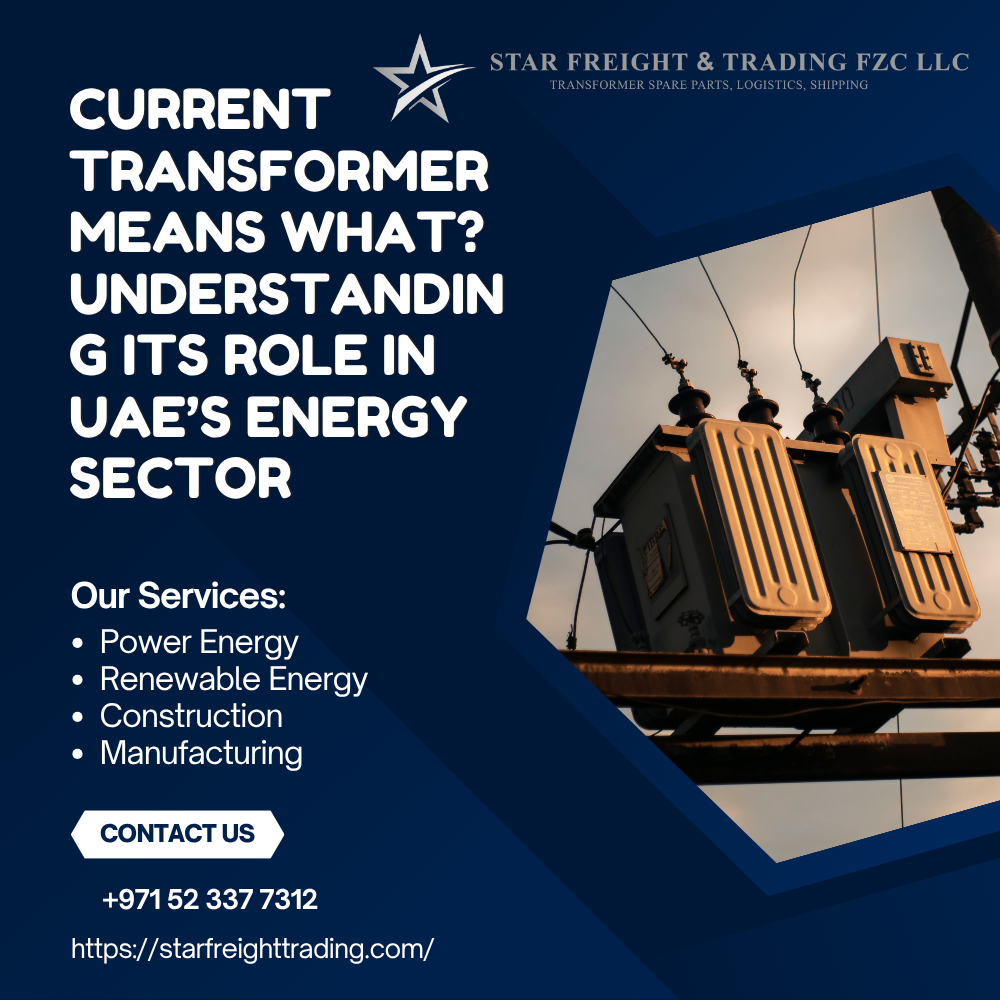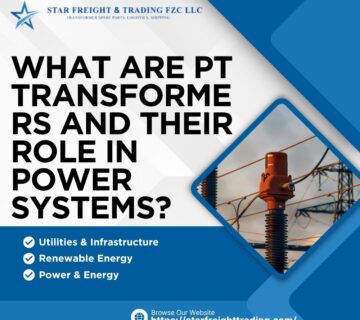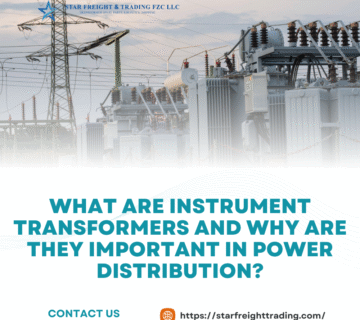In a country like the UAE, where reliable power distribution supports everything from high-rise offices in Dubai to large industrial plants in Abu Dhabi, electrical systems need to be both accurate and safe. One device that plays a surprisingly crucial role in making this happen is the current transformer, often called a CT.
If you’ve ever wondered, current transformer means what exactly? — or why engineers, facility managers, and utilities depend on them — this guide will walk you through their purpose, function, and importance in the UAE’s growing energy sector. We’ll also highlight how Star Freight Trading supports businesses with quality CT solutions in the region.
What Is a Current Transformer?
A current transformer is an electrical device designed to reduce high alternating current (AC) to a smaller, manageable value while keeping the ratio accurate. This scaled-down current can then be safely measured and monitored by meters, relays, and protection systems.
Think of it as a translator between high-energy power lines and sensitive measuring instruments. Without it, directly connecting meters to high-voltage lines would be dangerous and impractical.
Why Current Transformers Matter in the UAE
The UAE’s energy sector is built on reliability. High-voltage transmission lines feed substations, which distribute power to industries, commercial complexes, and homes. Monitoring this network accurately is critical to avoid overloads, detect faults, and ensure fair energy billing. Products
In such a system, CTs:
-
Protect sensitive measuring devices from dangerously high currents.
-
Provide accurate data for energy management.
-
Enable protective relays to act quickly in case of faults.
-
Support compliance with international and local safety standards.
How a Current Transformer Works
Current transformers operate on the principle of electromagnetic induction. They have three main parts:
-
Primary winding – Carries the high current to be measured. This could be just a single turn of a large conductor.
-
Magnetic core – Concentrates the magnetic field created by the current.
-
Secondary winding – Contains many turns of fine wire, producing a smaller current proportional to the primary.
For example, a CT with a 200:5 ratio will output 5 amps on its secondary when 200 amps flow through its primary. This reduced current can be measured safely and accurately.
Types of Current Transformers
Different designs suit different applications. Common types include:
-
Wound CTs – Multiple turns in the primary winding, used in precise low-current measurements.
-
Bar-type CTs – A solid conductor forms the primary; ideal for high-current, heavy-duty use.
-
Toroidal CTs – No physical primary winding; the conductor simply passes through the CT’s core.
-
Split-core CTs – Can be opened to fit around an existing conductor without disconnecting the circuit.
CTs vs. PTs — What’s the Difference?
In power systems, CTs (Current Transformers) are often used alongside PTs (Potential Transformers):
-
CT – Steps down current for measurement and protection.
-
PT – Steps down voltage for safe measurement.
Together, they allow engineers to safely monitor both current and voltage in high-power systems.
Accuracy Classes and Standards
The accuracy of a CT is critical. If the ratio is even slightly off, it could affect billing and system protection. The International Electrotechnical Commission (IEC) defines accuracy classes, such as:
-
Class 0.2 or 0.5 – Very precise, used for revenue metering.
-
Class 1 – Suitable for general monitoring.
-
Protection Classes (5P, 10P) – Designed to trigger protection relays during faults.
In the UAE, compliance with IEC standards is essential for utility and industrial installations. Our Services
Installation Best Practices
Installing CTs requires expertise. Factors to consider include:
-
Choosing the right ratio for expected current levels.
-
Checking the burden (load) on the CT’s secondary circuit to maintain accuracy.
-
Correct polarity connections to avoid false readings.
-
Grounding one side of the secondary to improve safety.
-
Never open-circuiting the secondary while the primary is energized, as it can cause dangerously high voltages.
Role in UAE Energy Projects
In the UAE, CTs are used in:
-
Utility substations to monitor transmission lines.
-
High-rise commercial towers for accurate tenant billing.
-
Industrial facilities to manage heavy machinery loads.
-
Renewable energy plants to measure and integrate solar or wind generation.
Given the country’s ambitious infrastructure plans, CT demand is expected to remain strong.
Advantages of Current Transformers
Some key benefits include:
-
Safety – Reduces risk when measuring high currents.
-
Accuracy – Maintains reliable readings for billing and protection.
-
Cost-effectiveness – Eliminates the need for expensive, high-capacity measuring devices.
-
Isolation – Separates measuring circuits from high-voltage power lines.
-
Versatility – Works across utility, commercial, and industrial environments.
Star Freight Trading — Supplying Quality CTs in the UAE
When it comes to sourcing electrical components in the UAE, Star Freight Trading is a trusted name. They supply a range of CTs designed to meet the needs of diverse applications, from compact split-core models for retrofits to heavy-duty bar-type CTs for substations.
Their team not only provides products but also offers guidance on:
-
Selecting the right CT ratio and class.
-
Ensuring compliance with IEC and local regulations.
-
Integrating CTs into existing energy management systems.
With a strong network of suppliers and a focus on quality, Star Freight Trading helps UAE businesses maintain reliable and safe power distribution systems.
Real-World Example — Industrial Energy Management
A manufacturing plant in Sharjah needed to monitor multiple production lines to identify which ones consumed the most power. Installing CTs at each distribution panel allowed the plant to:
-
Track consumption in real time.
-
Detect overloads before equipment failure.
-
Allocate costs accurately across departments.
This upgrade reduced energy waste and improved operational efficiency, showcasing the value of CTs beyond basic measurement.
The Future of Current Transformers in the UAE
As the UAE transitions toward smart grids, CTs are evolving too. New developments include:
-
Digital CTs – Offering direct data output for SCADA and IoT systems.
-
Compact designs – Fitting into modern switchgear.
-
Improved materials – Enhancing accuracy and durability in harsh conditions.
Companies that stay ahead in adopting these advancements will be better prepared for the UAE’s fast-changing energy landscape.
Conclusion
So, current transformer means what? In simple terms, it’s a device that makes high current measurable, safe, and manageable. In a country like the UAE, where infrastructure reliability is essential, CTs are key to safe and efficient power distribution.
Whether for utility substations, industrial plants, or commercial buildings, choosing the right CT — and the right supplier — matters. With expertise and quality products, Star Freight Trading ensures UAE businesses get reliable current measurement solutions that keep their operations running smoothly.
Frequently Ask Questions
Q. Current transformer meaning — what is it?
A. A current transformer (CT) is an electrical device that steps down high alternating current to a safe, smaller value for accurate measurement, monitoring, and protection in power systems.
Q. Why is a current transformer used in the UAE’s energy sector?
A. In the UAE, CTs protect meters and relays from dangerous high currents, provide accurate data for billing, and ensure safe, reliable power distribution across commercial, industrial, and utility networks.
Q. What is the main function of a CT?
A. The main function of a CT is to make high current measurable by scaling it down proportionally, allowing meters and protection systems to work safely and effectively.
Q. What are CT and PT used for?
-
CT (Current Transformer): Measures current for metering and protection.
-
PT (Potential Transformer): Steps down voltage for safe monitoring.
Both are essential in UAE substations, factories, and high-rise buildings.
Q. What are the advantages of a current transformer?
-
Enhances safety when measuring current.
-
Provides accurate, proportional readings.
-
Electrically isolates measuring devices from high-voltage lines.
-
Works in diverse applications, from factories to renewable energy plants.
Q. Why is CT measurement important in UAE industries?
A. CT measurement allows UAE businesses to monitor load, detect faults early, and manage energy use more efficiently, directly reducing costs and downtime.





No comment